
Latest Articals

6 Creative B2B Marketing Campaigns That Actually Work
Let’s be real for a second. B2B marketing has a reputation for being… kind of boring. For a long time, the game plan was pretty simple: write a long, technical report, host a dry webinar, and send a bunch of cold emails. But that old way of doing things just doesn’t work anymore.
Today’s B2B buyers aren’t robots. They’re scrolling through social media, watching videos, and looking for content that’s actually interesting, even when they’re making big, important decisions for their company. They want to be inspired, not just informed.
So, how do you get noticed in a crowded market? How do you create B2B marketing campaigns that are creative and effective? It’s all about stepping outside the usual playbook and bringing a bit of personality to your work.
What Exactly is a B2B Campaign?
Before we dive into the fun stuff, let’s quickly clear up some marketing jargon. You’ve probably heard of B2B marketing,but what does it really mean? B2B stands for “business-to-business.” It’s different from B2C (“business-to-consumer”),which is when you sell a product directly to a single person, like a pair of sneakers or a TV.
In a B2B campaign, you’re not selling to one person; you’re selling to a whole company. Your customers are other businesses, and you’re trying to get them to buy your service or product.
So, a B2B campaign is a planned series of marketing activities that all work together toward one goal. Think of it like a coordinated effort. Instead of just sending one email, a campaign might include a series of emails, a few social media posts, a video, and a special report—all focused on convincing a company to buy from you.
The big difference is that B2B campaigns usually have a longer sales cycle and involve more people. You have to convince not just one person, but a whole team of decision-makers. That’s why these campaigns need to be smart, helpful,and creative. They have to build trust over time, not just get a quick sale.
Here are six fresh ideas that can help you stand out.
1. “Edu-tainment” Content: Make Learning Fun
Forget those long webinars that put everyone to sleep. People don’t have time to sit through a boring presentation. They want to learn quickly and easily. The goal is to mix education with entertainment—think of it as “edu-tainment.”
- The Idea: Create a content series that teaches your audience about a complex topic in a fun way. It could be a mini-documentary, an animated video, or a podcast with a compelling story. Instead of just listing facts, you’re telling a story that people want to follow.
- For example: Let’s say you sell project management software. Instead of a boring report on “project management best practices,” you could create a 5-episode video series called The Project Team’s Big Fix. Each episode could show a fictional team struggling with a common problem—like missed deadlines or bad communication—and then show how your software helps them solve it. You’d share these videos on social media and in your emails, building excitement for the next episode.
- Why it Works: People love a good story. By making learning fun, you make it easy for people to pay attention and remember what you do. This shows that your company is smart and approachable, and it builds trust long before a sales call ever happens. It’s a great way to guide people who are just starting to learn about your solution toward a sale.
2. “Choose Your Own Adventure” Experiences
These days, generic content gets ignored. If it’s not for them, people just swipe right past it. Real personalization is about making a person feel like the content was made just for them.
- The Idea: Instead of a single webpage or brochure, create an interactive experience that changes based on what the user wants. It’s like a “choose your own adventure” book, but for your business. The path they take and the information they see depend on their role in their company or the specific problems they need to solve.
- For example: A cybersecurity company could create a “Threat Level Quiz” on their website. The user would answer a few simple questions about their company, like their industry and their biggest security fears. The tool would then create a custom “threat profile” just for them, with personalized tips and suggestions for products that would actually help. They could even download a special report to share with their boss.
- Why it Works: This is super effective because it gives people something useful right away. They feel seen and understood. And for you, it’s a great way to learn exactly what a potential customer needs. The information they give you helps your sales team start the conversation on the right foot, making them feel like a helpful partner instead of a pushy salesperson.
3. The “Unboxing” Experience for Services
Who says unboxing is only for physical products? In a world where everything is digital, a real, physical package can make a huge impact. This is all about giving your service a tangible feel.
- The Idea: If you sell a service or a software subscription, create a special “welcome kit” that you send to new clients. It’s more than just an email; it’s a real box filled with branded items, a personal note, and a cool guide to your service. It’s a way to make your service feel special.
- For example: A B2B marketing agency could send a new client a sleek box with a notebook, a nice pen, and an infographic that shows a clear plan for their project. They could also include a small bag of coffee with a note that says, “Let’s brew some success together!” The package would also have a personal letter from their project manager, outlining goals and what to expect.
- Why it Works: It creates a memorable experience in a digital world. When a client gets this package, they feel valued and excited. It makes them feel good about their decision to hire you and helps build a strong relationship right from the start. Plus, people love to share cool things they receive, which can lead to free social media promotion for you.
4. Partnered Content & Expert Hubs
You don’t have to do it all alone. A great way to get noticed is by working with other businesses that have a similar audience but aren’t your direct competition.
- The Idea: Team up with a complementary business or an expert in your field to create something cool together. It could be a joint report, a series of webinars, or a collaborative blog series. The goal is to combine your knowledge with theirs to make a resource that’s even more valuable than what either of you could do alone.
- For example: A finance software company could partner with a business consulting firm. Together, they could publish a report on “The State of Small Business Finance.” They could then host a series of online discussions about the findings, inviting clients and potential customers from both companies to join.
- Why it Works: It immediately helps you reach a whole new audience that is interested in what you do. It also makes you look more credible because you’re working with another expert. This kind of teamwork builds a powerful network of partners and can lead to a lot of high-quality leads for both companies.
5. Interactive Tools & Calculators
In the business world, people want to know how you can help them save time or money. A simple, easy-to-use tool can show them the value of your product right away.
- The Idea: Create a free online tool that helps your potential customers solve a small problem or figure out how much money they could save. It could be a simple calculator, a quiz, or a configurator that helps them build a solution.
- For example: A logistics software company could create a “Shipping Cost Calculator.” A user could type in their current shipping costs, how much space they have in their warehouse, and how fast they sell their products. The tool would then show them a score for how efficient they are and tell them how much money they could potentially save by using a better system. The results page would offer a call to action to talk to a consultant.
- Why it Works: This is incredibly practical. It gives people real, usable information right away. It helps them see for themselves that they have a problem and that your product is the solution. It also gives your sales team valuable information about what the customer needs, making the sales process much easier and more effective.
6. Surprising Guerrilla Marketing
Don’t be afraid to do something a little bold and unexpected to get attention. Guerrilla marketing is all about using creativity to make a big impact without a huge budget. In the B2B world, this means using a physical, surprising touch to stand out from all the digital noise.
- The Idea: Think outside the typical LinkedIn ad. You could create a highly targeted physical mailer that uses Augmented Reality (AR) when scanned. The goal is to deliver a shocking or intriguing message that people have to pay attention to.
- For example: A cybersecurity company could send a few high-value potential clients a black envelope. Inside, there would be a single, sleek card with a QR code. When they scan it, an AR experience would launch on their phone, showing a “digital fortress” being attacked by hackers. At the end, your company’s logo would appear as the shield that stops the attack.
- Why it Works: It’s unexpected and personal. It cuts through all the digital clutter and creates a brand experience that’s impossible to ignore. It gets people talking and shows that your company is innovative and cool.
The Big Takeaway: Be a Real Human
The main thing to remember about all these creative B2B marketing campaigns is that they’re all about being human. B2B doesn’t have to be boring. It’s about solving serious business problems with creative, memorable, and often surprising solutions.
Stop doing what everyone else is doing. The B2B marketers who win are the ones who dare to be different, who put real value and interesting experiences first. Now go out there and build campaigns that not only get clicks but also spark conversations and build lasting partnerships.
Recent Blogs

A Beginner’s Guide to On-Page vs. Off-Page SEO
Let’s be honest—SEO can feel overwhelming when you’re just starting out. Keywords, backlinks, meta descriptions… it’s enough to make anyone’s …

How to Choose the Right Web Agency for Your Business
Choosing a web agency can feel overwhelming. Dozens of agencies promise sleek designs, higher traffic, and incredible ROI. But here’s …

Is a Website Redesign Right for Your Business?
If your website feels more like a digital brochure collecting dust than a tool driving new business, you’re not alone. …

